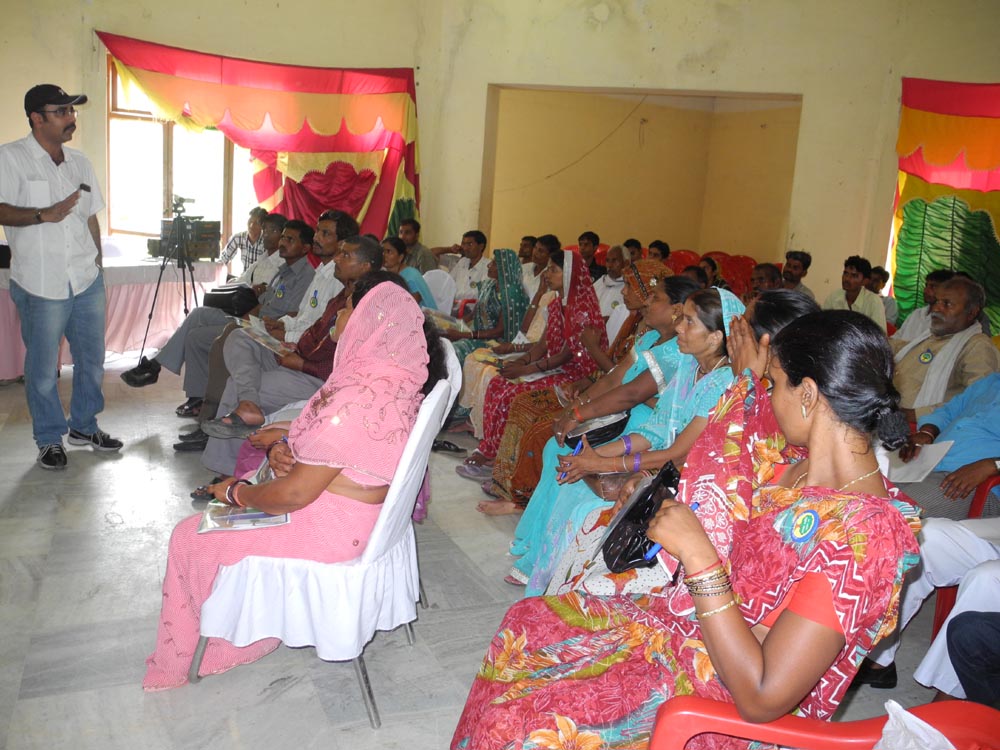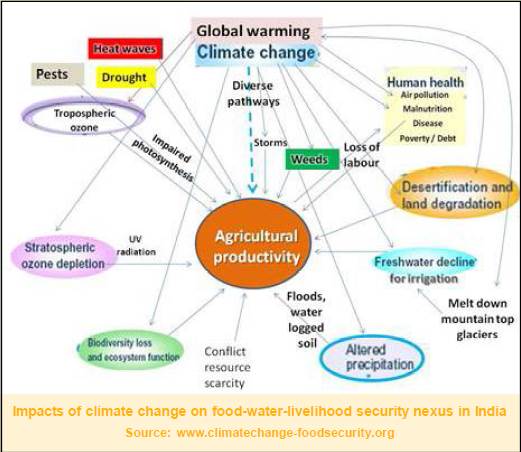|
Addressing Impacts of
Climate Change in India: Climate Change: A Global Threat with Localised Implications C limate change is recognised as a core concern for national-level poverty reduction strategies across the world. Impacts such as temperature rise, changing precipitation conditions and severity of extreme events threaten to annul any development gains being made, particularly in the context of vulnerable regions and communities. According to future projections by IPCC’s 5th Assessment Report, global surface temper ature
increase by the end of 21st
century is likely to exceed ature
increase by the end of 21st
century is likely to exceed 1.5°C relative to the 1850 to 1900 period for most scenarios, and is likely to exceed 2.0 °C for many scenarios. In the coming future, these impacts are likely to exacerbate existing economic, political and humanitarian stresses and transform life on earth as we know it. The global threat of climate change is likely to affect food, water and energy security, which are crucial for addressing basic needs especially those of marginalised communities worldwide. India is particularly vulnerable to climate change owing to its geographical diversity, greater dependence on agriculture, increasing exploitation of natural resources coupled with population growth and socio-economic challenges. According to the Ministry of Environment and Forests, Government of India, severe climate change impacts will be observed in India in the coming years. Annual mean surface air temperature will increase from 1.7°C to 2°C by 2030. A 3% to 7% increase in summer monsoon rainfall will be observed by 2030 as compared to 1970 and the frequency of rainy days (2.5+mm) will decrease in most parts of the country1. Some of these potential impacts will adversely impact availability of water resources, agricultural productivity, food and livelihood security.Climate Change Initiatives and Policy Mechanisms In developing and fast growing economies like India, simultaneous climate change actions at the local level have become as important as climate negotiations at the global level. India has committed itself to reducing its emissions intensity by 20-25% of its 2005 levels by 2020 2.While ambitious mitigation targets are persistently being proposed internationally, localised adaptation strategies are also making their way in nationally steered action plans. National Action Plan on Climate Change (NAPCC), State Action Plan on Climate Change (SAPCC), flagship programmes such MGNREGS, JNNURM etc. are some attempts to aid vulnerable communities to adapt. India’s National Action Plan on Climate Change (NAPCC) has already set a landmark for initiating climate change mitigation and adaptation actions in the country. The eight national level missions emerging from NAPCC cater to address socio-economic and environmental concerns arising from climate change. India also recognises that strategy for addressing climate change has to be based on a sustainable development strategy which is particularly addressed in the 12 th Five Year Plan of the country. Current government expenditure in India on adaptation to climate variability exceeds 2.6% of the GDP with agriculture, water resources, health and sanitation, forests, coastal zone infrastructure and extreme events being specific areas of concern3.Gaps and Challenges Despite several policy instruments on climate change adaptation and disaster risk reduction, impacts of extreme events in the country such as the Himalayan floods in Uttarakhand (2013) and devastating hailstorms (2014) in the country indicate towards increasing vulnerability of communities. National Level: At the national level, the National Action Plan on Climate Change (NAPCC) has put forward an action plan to address climate change issues specific to the country across various sectors. However, these action plans have not yet transformed into action oriented set of policies with set targets. It lacks sector specific implementation roadmaps for integration into development planning. Furthermore there is no clear allocation of funds to address and fulfill implementation of the action plans. State Level: Drafting of the State Action Plan on Climate Change (SAPCC) by different states opened new gateways for studying climate change at the grassroots level in the country. Twelve states have drafted these SAPCCs, of which nine have been endorsed by the Expert Committee and three are under consideration. However, many of these plans are dynamic documents and require incorporation of other essential components such as vulnerability assessments, GHG inventorisation, finance and budget allocations. Various state action plans lack clarity of climate science due to inadequate climate science research and investments. Several states also fail to define targets for specific actions. Some of the specific critiques of the SAPCCs developed so far are as follows: • Plans have been developed in a non-participatory mode with civil society and other non-state actors being involved only at the last stage. • Financial allocations are yet to be defined by the central ministries. • It is not clear how the role of SAPCCs would fit in the current institutional structure of the central-state relations and actions. • SAPCCs are also not clearly linked to planning processes at the state level. District Level: Looking at more micro level viz. district and sub-district level, development agendas are getting prioritised over natural resource conservation and disaster risk reduction (DRR) priorities. The existing approach of integrating DRR and poverty reduction strategies with climate adaptation is inadequate and limited scientific information available in formats inhibit decision makers to assess possible future impacts. Institutional challenges and information gaps do not provide a complete overview of climate impacted area leading to sector specific short term decisions rather than framing a science and evidence based holistic approach for long term actions. This deficiency is driven by a variety of factors including lack of climate change related information and communication capacity at the district and community level, insufficient scheme and policy outreach, and top-down budget allocation processes that do not necessarily reflect the needs on the ground. This is further aggravated by the lack of convergence between the departments both at the vertical level (village, block, district, state and national) and at the horizontal level (between departments). |
|
National Level Missions with the NAPCC • National Solar Mission • National Mission to Enhance Energy Efficiency • National Mission on Sustainable Habitat • National Water Mission* • National Mission on Sustainable Agriculture* • National Mission for Green India* • National Mission for Strategic Knowledge* • National Mission for Sustaining the Himalayan Ecosystem* * Directly pertains to climate adaptation |
|
Mainstreaming Climate Change Concerns in Planning While all these issues cripple formulated climate action in the country, civil society initiatives have developed innovative ways to address this development challenge. Mainstreaming climate change adaptation has emerged as a new area of focus for building resilience of vulnerable communities. Moving across horizontal and vertical levels of planning, climate adaptive planning aims to span across departments (agriculture, water resources, rural development etc.) and vertical bureaucratic levels (national, state, district, block and village). In one such initiative (Water and Climate Resilience Programme), Development Alternatives in association with India Water Partnership and Global Water Partnership is currently engaged in an action research project for integrating climate adaptive planning in sub-national decision making processes. The project has identified climate change vulnerabilities for Datia district in Madhya Pradesh and aims to develop climate responsive adaptation plans based on it. The pilot is presently identifying locale specific adaptation strategies for food and water security of the district and intends to integrate these strategies into village planning processes. Using a stakeholder engagement approach, this initiative is intended to increase the overall climate change understanding of the local communities and district officials and enhance their capacities to deal with its vagaries. The project is adopting a participatory and analytical approach and is engaging with communities and local level planners to integrate climate adaptive planning in decision making processes. Such civil society initiatives from India focusing on mainstreaming climate change adaptation in development planning have the potential for providing strong evidences for global climate negotiations. With the Adaptation Fund and National Adaptation Programmes for Actions (NAPAs) gearing up, it is time that such evidences from localised development planning are used for replication and as an answer to the problems faced by marginalised communities across the world. q Harshita Bisht Endnotes 1 Ministry of Environment & Forests. (2010). Climate Change and India: A 4x4 Assessment. Retrieved from http://moef.nic.in/downloads/public-information/fin-rpt-incca.pdf 2 http://finmin.nic.in/the_ministrydept _eco_affairs/economic_divccfu _index.asp 3 http://finmin.nic.in/the_ministrydept_ eco _affairs/economic_divccfu_index. asp |
